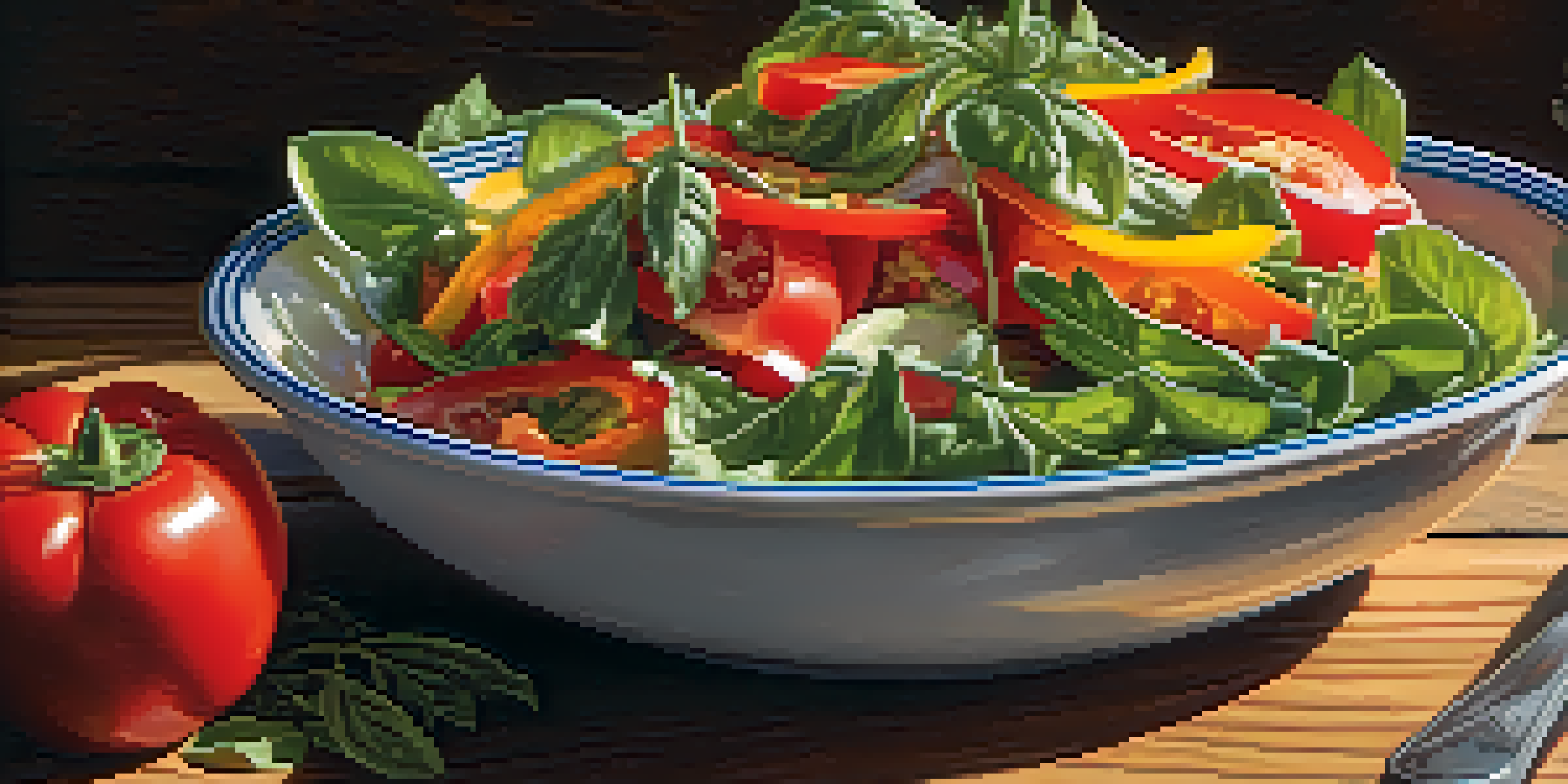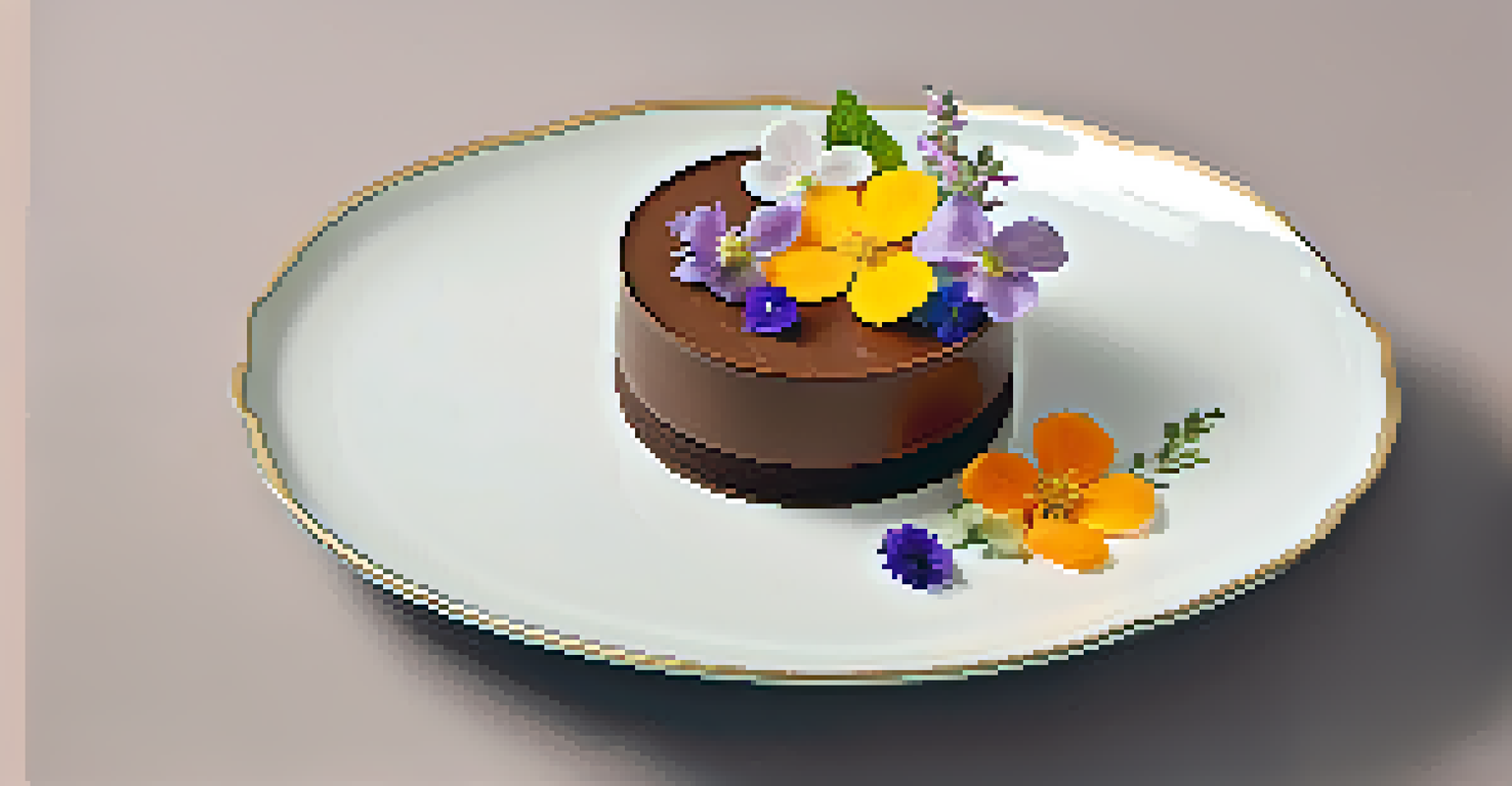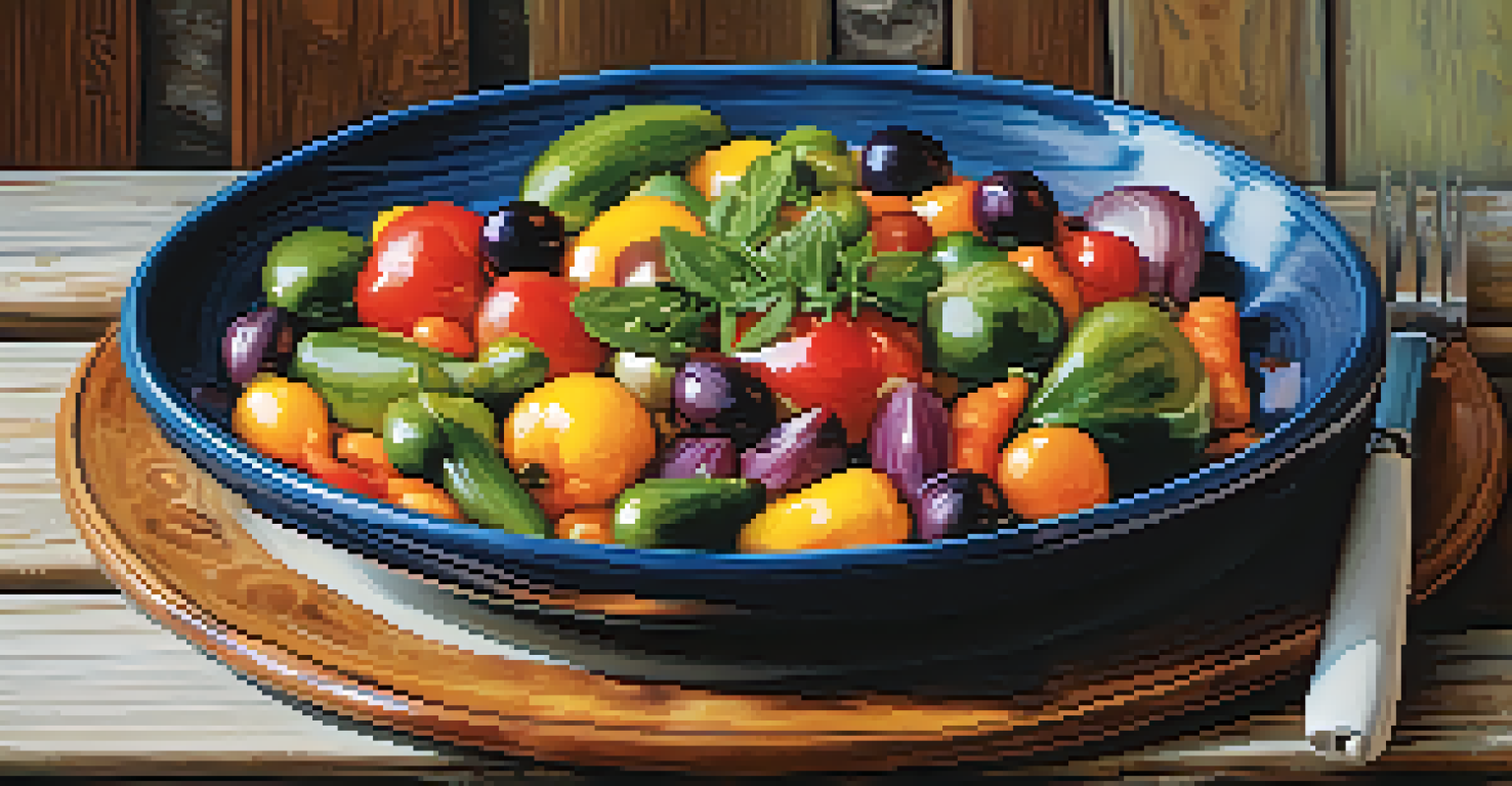The Aesthetic Appeal of Food: Painting with Culinary Techniques

The Intersection of Art and Food: A Visual Delight
Food has always been more than just sustenance; it is a canvas for creativity. Just as artists use paint to express emotions, chefs use ingredients to create visually stunning dishes. This intersection of art and food allows us to appreciate meals not only for their taste but also for their visual appeal.
Food is art, and art is food. It is a symbiotic relationship where creativity meets nourishment.
When we dine, our senses are engaged on multiple levels. The sight of a beautifully plated dish can evoke feelings of joy and anticipation, much like viewing a breathtaking painting. This aesthetic enjoyment often enhances our overall dining experience, making it memorable.
Consider the vibrant colors of a fresh salad or the delicate arrangement of sushi. Each element is thoughtfully placed, creating a visual story that invites us to explore the flavors within. This careful attention to detail transforms ordinary meals into extraordinary experiences.
Color Theory in Culinary Presentation
Color plays a crucial role in the presentation of food, much like in visual art. The use of complementary colors can make a dish pop and catch the eye. For example, the bright red of a ripe tomato against the green of fresh basil creates a vibrant contrast that invites us to taste.

Research shows that colors can influence our perception of flavor. Warm colors like red and orange can stimulate appetite, while cooler colors like blue may suppress it. This understanding allows chefs to strategically use color to enhance both the visual and gustatory appeal of their dishes.
Artistry in Food Presentation
Food is not just about taste; it's a visual canvas where chefs creatively combine colors, textures, and arrangements to enhance the dining experience.
By combining various colors on a plate, chefs create a feast for the eyes. Think of a colorful fruit tart, where the deep purple of blueberries meets the bright yellow of lemon curd. Such combinations not only look stunning but also suggest a range of flavors, heightening our anticipation.
Plating Techniques: Elevating Culinary Art
Plating is an art in itself, where chefs transform a simple dish into a masterpiece. Techniques such as stacking, layering, and using negative space can dramatically change the presentation. Just like an artist considers composition, chefs must think about how each element interacts on the plate.
Cooking is like painting or writing a song. Just as there are only so many notes or colors, there are only so many flavors—it’s how you combine them that sets you apart.
For instance, a minimalist approach can often be more striking than a crowded plate. A single piece of grilled fish elegantly placed with a smear of sauce can evoke sophistication. This simplicity allows the dish's flavors to shine while still engaging the diner’s eye.
Moreover, garnishes and sauces can be used to enhance visual appeal. A sprinkle of microgreens or a drizzle of balsamic reduction can add an artistic touch, making the dish feel complete. These small details can turn a simple meal into a work of art that tantalizes both the eyes and the palate.
Textures: The Unsung Hero of Culinary Aesthetics
When we think about food presentation, we often focus on color and arrangement, but texture is equally important. The contrast between creamy, crunchy, and chewy elements can create a dynamic experience on the plate. For instance, a creamy risotto paired with crispy fried shallots adds depth to the dish.
Texture not only enhances visual appeal but also affects how we perceive flavors. A dish that offers a variety of textures can keep the palate engaged, creating a more enjoyable dining experience. Think of a dessert that combines smooth chocolate mousse with a crisp cookie base for an exciting contrast.
Cultural Influences on Aesthetics
Different cultures shape culinary aesthetics, reflecting their unique histories and philosophies through food presentation styles.
Chefs often play with textures to tell a story through their dishes. A layered dessert, for example, may feature soft sponge cake, rich custard, and a crunchy topping to provide a delightful journey for the senses. This thoughtful combination elevates the dish beyond mere taste, making it a feast for both the eyes and the mouth.
The Role of Culture in Culinary Aesthetics
Culinary aesthetics are deeply influenced by cultural traditions and practices. Different cultures have unique approaches to food presentation, reflecting their values and histories. For instance, Japanese cuisine often emphasizes simplicity and elegance, focusing on seasonal ingredients and minimalistic designs.
In contrast, Mediterranean cuisine celebrates abundance, with vibrant colors and hearty servings that showcase the region's rich agricultural bounty. Each culture's aesthetic choices offer a glimpse into their culinary philosophy, enriching our understanding of food as an art form.
As we explore global cuisines, we can appreciate how cultural backgrounds shape our perception of beauty in food. This diversity allows us to experience a wide range of artistic expressions, making dining a journey through different worlds and traditions.
Sustainable Practices: Aesthetic Responsibility
In recent years, the conversation around sustainability has also found its way into the culinary world. Chefs are becoming increasingly aware of the aesthetic impact of their ingredient choices. By using locally sourced and seasonal produce, they not only enhance the visual appeal of their dishes but also support their communities.
Sustainable practices encourage chefs to think creatively about their presentations. A dish featuring heirloom vegetables not only looks beautiful but also tells a story of biodiversity and responsible farming. This connection between aesthetics and ethics elevates the dining experience on multiple levels.
Sustainability in Culinary Art
Chefs are increasingly adopting sustainable practices, using local and seasonal ingredients to create visually appealing dishes that also tell a story.
Moreover, eco-friendly plating techniques, such as using biodegradable or reusable materials, can further enhance the aesthetic appeal while promoting sustainability. A beautifully presented dish served on a handmade ceramic plate can create a lasting impression, reminding diners of the importance of mindful consumption.
The Future of Culinary Aesthetics: Trends on the Horizon
As the culinary landscape continues to evolve, so do the trends in food presentation. We are witnessing a rise in innovative plating techniques, such as edible flowers and unconventional ingredients that challenge traditional aesthetics. This experimentation encourages chefs to push boundaries and redefine what beauty looks like in food.
Social media platforms like Instagram have also influenced culinary aesthetics, promoting visually stunning dishes that are designed to be shared. This trend has prompted chefs to create dishes that not only taste great but also photograph beautifully, merging the worlds of culinary art and digital storytelling.

Looking ahead, we can expect to see even more creativity in food presentation. Chefs will likely continue to explore new ingredients, techniques, and cultural influences, ensuring that the aesthetic appeal of food remains a dynamic and exciting aspect of the culinary experience.